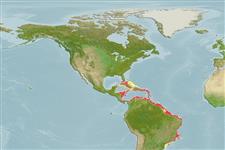Environment: milieu / climate zone / depth range / distribution range
Écologie
marin; saumâtre démersal; profondeur 0 - 75 m (Ref. 5217), usually 0 - 10 m (Ref. 26268). Tropical; 25°N - 30°S, 87°W - 30°W (Ref. 26268)
Western Atlantic: Puerto Rico, Cuba and Hispaniola but unknown from the Bahamas. Continental margin of Central America (Belize, Nicaragua, Costa Rica and Panama) to South America (Colombia, Guyana, suriname, Tobago and Brazil (Rio de Janeiro).
Taille / Poids / Âge
Maturity: Lm ? range ? - ? cm
Max length : 25.0 cm TL mâle / non sexé; (Ref. 35237); common length : 20.0 cm TL mâle / non sexé; (Ref. 5217); poids max. publié: 51.30 g (Ref. 118626)
Épines dorsales (Total) : 0; Rayons mous dorsaux (Total) : 89 - 99; Épines anales: 0; Rayons mous anaux: 75 - 84.
A shallow water species (1-51 m) (Ref. 26268), found over mud or sand bottoms (Ref. 5217) where it feeds on small benthic invertebrates likes annelids and crustaceans. Normally found along sand banks near the mouth of rivers (Ref. 35237).
Life cycle and mating behavior
Maturité | Reproduction | Frai | Œufs | Fécondité | Larves
Munroe, T.A., 1998. Systematics and ecology of tonguefishes of the genus Symphurus (Cynoglossidae: Pleuronectiformes) from the western Atlantic Ocean. Fish. Bull. 96(1):1-182. (Ref. 26268)
Statut dans la liste rouge de l'IUCN (Ref. 130435: Version 2024-1)
Menace pour l'homme
Harmless
Utilisations par l'homme
Pêcheries: intérêt commercial mineur
Outils
Articles particuliers
Télécharger en XML
Sources Internet
Estimates based on models
Preferred temperature (Ref.
123201): 25.8 - 28.1, mean 27.5 °C (based on 680 cells).
Phylogenetic diversity index (Ref.
82804): PD
50 = 0.5000 [Uniqueness, from 0.5 = low to 2.0 = high].
Bayesian length-weight: a=0.00646 (0.00411 - 0.01014), b=3.07 (2.93 - 3.21), in cm total length, based on LWR estimates for this species & (Sub)family-body (Ref.
93245).
Niveau trophique (Ref.
69278): 3.3 ±0.39 se; based on food items.
Résilience (Ref.
120179): Haut, temps minimum de doublement de population inférieur à 15 mois (Preliminary K or Fecundity.).
Fishing Vulnerability (Ref.
59153): Low vulnerability (15 of 100).
Nutrients (Ref.
124155): Calcium = 205 [96, 352] mg/100g; Iron = 1.13 [0.57, 2.01] mg/100g; Protein = 17.9 [15.9, 20.1] %; Omega3 = 0.149 [0.074, 0.293] g/100g; Selenium = 54.3 [26.2, 110.8] μg/100g; VitaminA = 13.7 [4.3, 42.8] μg/100g; Zinc = 1.3 [0.9, 1.9] mg/100g (wet weight);
